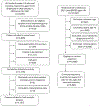Tattooing and risk of melanoma: a population-based case-control study in Utah
- PMID: 40839395
- PMCID: PMC12404683
- DOI: 10.1093/jnci/djaf235
Tattooing and risk of melanoma: a population-based case-control study in Utah
Abstract
Background: Tattooing can deliver carcinogens directly into the skin and cause immunologic responses, yet the relationship between tattooing and melanoma risk is unknown.
Methods: In a population-based case-control study with 1,167 melanoma cases (566 in situ; 601 invasive) and 5,835 frequency-matched controls, we examined tattooing and melanoma risk using multivariable logistic regression to calculate odds ratios (ORs) and 95% confidence intervals (CIs).
Results: While ever receiving a tattoo was not strongly associated with melanoma risk, heavier tattooing exposure was associated with decreased risk. Overall melanoma risk was decreased among individuals who had received four or more tattoo sessions (OR 0.44 [95% CI 0.27-0.67]) and individuals who had three or more large tattoos (OR 0.26 [95% CI 0.10-0.54]) compared with those who were never tattooed. Invasive melanoma risk was also decreased among individuals who received their first tattoo before age 20 (OR 0.48 [95% CI 0.29-0.82]) compared with never tattooed individuals.
Conclusions: Our findings suggest more tattoo exposure is associated with reduced melanoma risk, which does not support previously hypothesized associations between tattooing and increased melanoma risk. Unmeasured confounding is likely to contribute to our findings as we were not able to control for important melanoma risk factors. Potential causes of these associations could include sun exposure-related behaviors or immune responses to tattooing. Further investigation is warranted to clarify these relationships.
© The Author(s) 2025. Published by Oxford University Press.
Conflict of interest statement
Institutional pilot funding from the Huntsman Cancer Institute supported this work. Lindsay J. Collin was supported by R00CA277580 from the National Cancer Institute of the National Institutes of Health. Lindsay J. Collin reports personal fees from Epidemiologic Research & Methods, LLC outside of the submitted work.
Figures
References
-
- Schaeffer K, Dinesh S. 32% of Americans have a tattoo, including 22% who have more than one. Pew Res. Cent https://www.pewresearch.org/short-reads/2023/08/15/32-of-americans-have-... (accessed Aug 16, 2023).
-
- Foerster M, Schreiver I, Luch A, Schüz J. Tattoo inks and cancer. Cancer Epidemiol 2020; 65: 101655–101655. - PubMed
-
- Regensburger J, Lehner K, Maisch T, et al. Tattoo inks contain polycyclic aromatic hydrocarbons that additionally generate deleterious singlet oxygen: PAHs in tattoo inks. Exp Dermatol 2009; 19: e275–81. - PubMed
-
- Engel E, Spannberger A, Vasold R, König B, Landthaler M, Bäumler W. Photochemical cleavage of a tattoo pigment by UVB radiation or natural sunlight. JDDG; 2007; 5: 583–9. - PubMed
-
- Hauri U, Hohl C. Photostability and breakdown products of pigments currently used in tattoo inks. Curr Probl Dermatol 2015; 48: 164–9. - PubMed
Grants and funding
LinkOut - more resources
Full Text Sources


